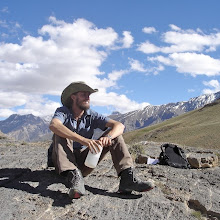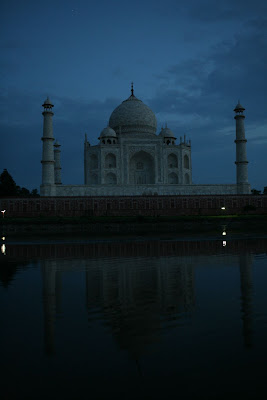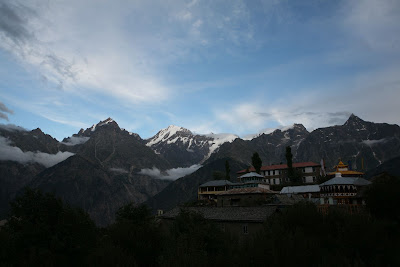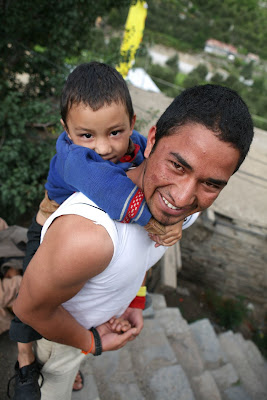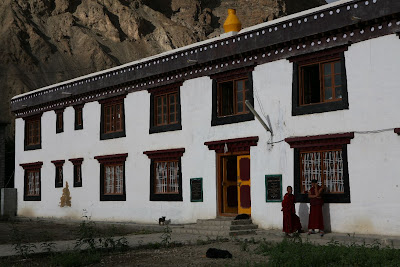
I drove up to Langza, one of the high villages, to see how my friend Anjan's house had turned out (I posted pictures of the construction back in early June). I stopped in at Nawong's house to see how this young guide-to-be that I'd spent some time with was fairing, and learned that he had fallen off his mount in a horse race at a local festival a few days ago. He was not seriously hurt. On the way in I took pictures of his grandfather brewing Chang (barely beer) just outside the kitchen-- more daily life in Spiti.

Traders and villagers came to Kaza from all over for a local festival. While centered around commerce and not really so much a "cultural" festival, the event also featured different kinds of dancing, as well as a very exciting horserace.

In Kaza I always stayed at the same place, the Phun-tsok Palbar Guesthouse. The couple that owned it were two of my favorite, two of the sweetest, people in Spiti. Pictured here is the Mother (Amma)who, as well as appearing in several local, traditional dances, also made me tea almost every morning, smiled really big when she laughed, often, and in general made me feel so welcome in her home-- more like a guest or a family member than a paying tenant.

My three of my guest house family's children were home, two from school in Shimla, during the festival. Here brother (Chan-chuk) and sister took me to the festival's horse race. As we sat around waiting for the race to start, plenty of time as things don't happen punctually in Spiti, Chan-chuk made bets on which horse would win, what village people were from, and which yak was the strongest.

Many people came to the horse race, and before it started we had plenty of time to admire the horses. They were all very small horses, and, since horses are ridden very little in Spiti and mostly just at festivals, they are mostly untamed. Regardless, the riders saddle the horses only with a blanket and some light reigns.

Here's a little pre-race excitement, and a taste of the untamed nature of the horses and the recklessness of the riders.

The race, though it was only two laps and lasted only about two minutes, was really quite exciting. The riders rode very fast, at their limit, around flags set up in a large dirt feild/arena. Riders and horses mixed closely, collided, fell and fought around the track-- never a dull moment.

Here's the finish: neck and neck two riders shoulder to shoulder, horses nose to nose, dash for the final flag. The rider in the foreground, white T-shirt, would be declared the winner.

At sunset the texture of the houses stands out. I will always sentimentalize the mud houses of Spiti.

This is Khan Mo, or Black Mountain, the day before I would leave to climb it. Those blue skies would not last. Note there are two summits, one to the right and one to the left; I would only make it to the first summit (at left) at about 5,980 meters (the right is 5,995meters) due to a big old snow storm.

Mani Mountain at 6,300 meters, here painted by sunset, dominates the views looking south-east down Spiti Valley. Mani, part of the sacred six syllable mantra Oh Mani Padme Hum, translates to Jewel, which I aggree is a very good name for the peak.

How many mornings and evenings did I sit and eat in this kitchen? Every time a special moment immersed in another culture. Here the my family eats dinner.

A close up of the Kee Monestary from below taken on my way to climb Khan Mo.

As I hiked up to about 5000 meters to establish a base camp for my summit bid the next morning, I watched nervously as clouds rolled in and some light rain fell in the evening. I would hear intermittant rain during the night; at that altitude I slept very lightly.

Breathless and having new respect for high altitude climbers, I arrived at the summit in visibility slashing snow fluries. The mountain was mocking my futile toting of 20 pounds of camera gear up its steep skree flanks. I almost forgot to take any pictures at all, but here I am: cold and grinning. From here the proper summit is probably a 1 kilometer ridgewalk away, but because of the prospect of some technical steps and the massive impairment to visibility from cloud and snow, I opted to go down. I spent the whole next day with a pounding AMS headache. While 19,600 feet is pretty damn high, Everest, by comparison, is 9,400 feet higher; I can't imagine what it's like trying to breathe up there.


I am always impressed by the flowers that grow at high altitude. Both of these, and a few other varieties, were blooming in August at about 5000 meters, or over 16,000 feet. And beautiful!

Hiking through the high hills on the way to and from Khan Mo I twice encountered a herd of about 150 Yaks. Something like a cow, something like a bison, these wooly beasts and their pointy horns thrive in the highlands. Known for their strength and calm temperment, I was no less intimidated by their size (and horns) as I walked through their midst on the way down.
Now I am in Leh, Ladakh, in the Kashmir region of Northern India. Over 500 kilometers from Srinigar, where most of the political unrest is seated, I am not in unusual danger of terrorist attrocities. It's beautiful up here, and sight more comfortable than life in Spiti, but also more crowded tourists. After a most epic drive up here from Spiti driving at times over 5000 meters, I have sold my motorcycle and am once again a humble pedestrian. I'll try to post again before I leave Leh on the 17th of September-- I think the two weeks between now and then will prove interesting.
Two months from coming home, I think about leaving India a lot. I'm having some initial butterflies about what readjusting to America, not to mention to working, will be like. I'm wondering where I'll live and what I'll do. Confident that I'll be able to answer these questions when I need to, I continue to try to live in each moment here and realize how one of a kind and important each second of this trip is. I am scared that when I get home I won't be able to make sense of it all, and will have wasted 9 months of my life. I continue to write this blog in hopes that sharing this experience has meaning for more than just myself, that, in reality, packing up and leaving home for so long was not a wholely selfish act. If you're reading, thank you; you give me needed strength. I hope that each of you will also share thoughts with me. I really love getting emails and comments.
Much love to everyone,
Ethan
